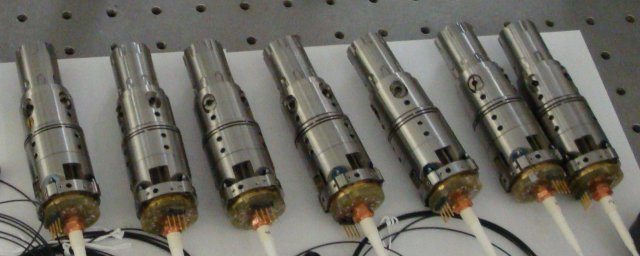The U.S. Army Research Laboratory’s Computational and Information Science Directorate’s Intelligent Optics Team, and partners, recently developed, engineered, demonstrated and delivered the world’s first known working Adaptive Phase Coherent Fiber Laser Array system, which will better enable Soldiers’ directed energy weapons and laser communication systems on the battlefield.
The key members of the Intelligent Optics Team include: Dr. Jiang Liu, electronics engineer, Dr. Leonid Beresnev, physicist, and Gary Carhart, electronics technician, all from CISD’s Atmospheric Sensing Branch.
The development of the system spurred from a collaborative agreement between U.S. Army Research Laboratory, known as ARL, the Defense Advanced Research Projects Agency, the Massachusetts Institute of Technology Lincoln Labs, Optonicus and various academic partners.
ARL’s efforts were central to the recent successful Defense Advanced Research Projects Agency real-world development of a 21-element optical phased array system, of which ARL developed and provided the low-power and high-power fiber subapertures and other key components including control electronics and operation software.
The demonstration was part of the Defense Advanced Research Projects Agency’s Excalibur program, the overall goal of which is to develop coherent optical phased array technologies as an enabler for scalable laser weapons.
The fiber laser array system, developed after more than a decade of research and testing, consists of phase locking and beam combining for multichannel, 7 and 19, fiber laser sub-aperture arrays. An ARL patent and patents related to the system are currently pending.
With this phase locking feature and compensation mechanism, physical disturbances such as vibration of the system and atmospheric turbulence will not affect the operation of the laser beams.
The system uses the internal interference feedback of multi-laser beam tails instead of using the conventional beam-splitter sensors placed on the output passage of the laser beams. This allows the system to deliver the same amount of total energy as a monolithic single-aperture laser, but the energy density is multiple times higher at the center of the combined beam.
This architecture allows the system to be dramatically reduced in size, weight and cost by multiple times compared to existing laser weapon systems, all while delivering the same power.
An innovative high-speed control algorithm “Stochastic Parallel Gradient Descent,” is applied to control the beams and their phases coherently in addition to compensating the atmospheric turbulence, maximizing the laser irradiance. An ARL patent for this is pending as well.
In terms of benefits to Soldiers on the battlefield, this one-of-a-kind system is making great strides.
The system architecture will allow for more efficient, more lethal, and more mobile and deployable laser weapon systems, thus it can be widely used by the Army as a directed energy laser weapon system in all platforms including both ground and aerial.
In addition, the output beam of the array can be used as a countermeasure system to quickly and accurately disable and destroy the incoming threat of missiles and other adversary reconnaissance.
“ARL’s coherent fiber laser arrays are the world’s first working devices and directed energy subsystem of its kind. They are the results of the diligent work of ARL researchers, for nearly a decade. I am so proud of our team for achieving such a significant milestone,” said Liu.
“The successful development and delivery of this system demonstrated the innovativeness and capability of ARL as a world-class research organization. ARL is a critical and vital piece in contributing to the nation’s defense research and development,” Liu said.
Future tests of the system will be conducted to reach the ultimate goal of developing a 100-kilowatt-class laser system in a scalable size, weight and power optical phased array configuration compatible with existing weapon system platforms that will further enhance the capabilities of Soldiers on the battlefield.
The Army Research Laboratory is part of the U.S. Army Research, Development and Engineering Command, which has the mission to develop technology and engineering solutions for America’s Soldiers.
RDECOM is a major subordinate command of the U.S. Army Materiel Command. AMC is the Army’s premier provider of materiel readiness–technology, acquisition support, materiel development, logistics power projection and sustainment–to the total force, across the spectrum of joint military operations. If a Soldier shoots it, drives it, flies it, wears it, eats it or communicates with it, AMC provides it.











